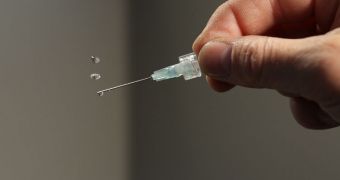A group of investigators at the US Department of Energy's (DOE) Argonne National Laboratory (ANL) announces the development of an acoustic levitator, a device that uses sound waves to levitate individual droplets of liquid.
The instrument holds great promise for improving drug development procedures, although the link may not be immediately apparent. Being able to hang individual droplets of solutions in the air could lead the way to new therapies with fewer side-effects, the ANL group explains.
The researchers say that the droplets they were able to levitate contained different pharmaceuticals, both amorphous and crystalline. These are the two main types of pharmaceutical structures, each carrying its own set of properties.
For starters, amorphous substances have an increased bioavailability, which means that they are more readily absorbed by organic tissue. They are also able to produce an effect in small quantities.
Conversely, crystalline substances are not that available biologically, and higher amounts are needed to produce the same effects. Unfortunately, they also have a higher risk of producing side-effects in the body. The problem is that the majority of active ingredients in drugs today have crystalline structures.
“One of the biggest challenges when it comes to drug development is in reducing the amount of the drug needed to attain the therapeutic benefit, whatever it is,” ANL X-ray physicist Chris Benmore says.
The expert who led the new investigation says that, unfortunately, most amorphous-state chemicals in a solution tend to want to become crystalline. This largely happens when the solution evaporates because it touches the walls of the vessels containing it.
“Most drugs on the market are crystalline – they don’t get fully absorbed by the body and thus we aren’t getting the most efficient use out of them,” explains the senior manager for Intellectual Property Development and Commercialization at ANL, Yash Vaishnav.
Benmore found that, in order to avoid the crystallization of active chemicals, he had to evaporate various solutions without them touching any surfaces. To do that, he used a device that NASA originally developed to simulate microgravity conditions, an acoustic levitator.
Using this device enables scientists to create pristine chemical samples, which can then be bombarded using high-energy X-ray light produced by ANL's Advanced Photon Source (APS) synchrotron facility.
“This allows amorphization of the drug to be studied while it is being processed,” explains APS project team member, Rick Weber.
The basic operating principle of an acoustic levitator is deceptively simple. You need two perfectly aligned speakers, capable of producing sound waves at 22 Hertz (Hz), slightly above the human audible range.
These speakers create two sets of sound waves that interfere with each other perfectly. Between the nodes where the two waves meet, there is no net transfer of energy. Since the acoustic pressure of the waves defeats gravity, light objects placed at these exact locations levitate.

 14 DAY TRIAL //
14 DAY TRIAL //